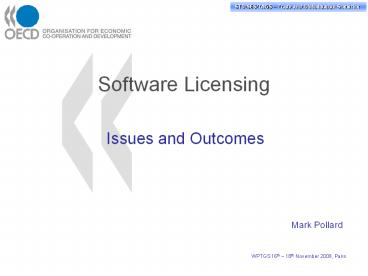Software Licensing - PowerPoint PPT Presentation
1 / 9
Title:
Software Licensing
Description:
One questionnaire would reduce the chance of double counting. ... BPM6 differentiates, but.... Most software sold in large volume, is sold with a perpetual license. ... – PowerPoint PPT presentation
Number of Views:77
Avg rating:3.0/5.0
Title: Software Licensing
1
Software Licensing
- Issues and Outcomes
Mark Pollard
2
Objectives
- To answer the questions raised at the
Inter-Agency Task Force meeting in Bangkok in
March 2009 - Is the collection of licenses for the use of
software goods and software services in a joint
enterprise survey, a pragmatic approach. - The feasibility of using pricing to differentiate
between goods and service license transactions. - To assess the current understanding among member
countries and the quality of what falls within
the data reported in goods and services in the
area of software and intellectual property.
3
A Joint Enterprise Survey?
- Is the collection of licenses for the use of
software goods and software services in a joint
enterprise survey, a pragmatic approach. - Users describe the collection of this data in a
single enterprise questionnaire as essential. - Few would argue that it is not the ideal.
- One questionnaire would reduce the chance of
double counting. - One questionnaire would also help consistency and
give a higher level of confidence when making
comparisons between goods and services data. - Logically software and the licensing of the
software, whether bought as a package or
separately should be treated in the same way - as
a cost of using the service but not always the
case.
4
Issues
- The method of delivery results in allocation to
either the goods or services account. - The collection for goods data is through
cross-border documentation and survey
questionnaires, administered by customs
authorities. - For trade in services, collection is through
business surveys, administered by NSOs,
supplemented with the bank settlement system in
some countries. - No single national collection agency has overall
responsibility. - Different primary purposes for the data
collection makes their combination rather
artificial. - Combination of tax data from potentially
different collection agencies. - Significant changes would be required to
introduce a single questionnaire, irrespective of
who took responsibility. - Additional processes would be needed for the
responsible national agency, including the
transfer and merger data from a third source
(extrastat)!
5
The Use of Pricing
- The value of software and its license cannot be
identified when sold as part of a hardware
package. For the purpose of coverage this isnt a
concern as the value of the traded good is
captured by the goods collections. - The value of bundled software packages (software
license) cannot be provided independently. - The value of non-perpetual licenses could be used
as a proxy for the license element in the bundled
package(s), but - Non-perpetual licenses are not collected under
BPM5. BPM6 differentiates, but. - Most software sold in large volume, is sold with
a perpetual license. - Most non-perpetual licences are sold for the use
of more specialist software and intrinsically
have a higher value. - However, the BPM definition negates the need as
it provides a clear distinction about what
software should be treated as a service and what
should be treated as a good.
6
Quality of Current Collection
- I contacted a large number of statistical
agencies. - How do you define software and software licenses
and how do contributors respond?. - Any evidence of mis-reporting of intellectual
property e.g. reporting services in a 'not
elsewhere classified category? - Any other issues with the collection of the these
data? - I received responses from ten Member Countries
Ireland, Spain, Denmark, Switzerland, Finland,
Canada, Austria, Czech Republic, Germany and UK. - Little difficulty with interpretation.
Definitions used were consistent and there was no
awareness of any serial mis-reporting or other
quality issues. - There is clarity about the definitions provided
by MSITS, which countries can and do apply
sensibly. - While a number of distinctions are made in the
guidance, the idea of mass-produced versus
customised makes the line of demarcation quite
clear. - This pragmatic approach manages the burden,
minimises the risk of double counting, helps
consistency and provides confidence when making
comparisons between goods and services data.
7
Quality of Current Collection
- A further simplification to improve quality would
be to treat all software and software licensing
as a service (excluding hardware bundles). This
was also a finding of the worldwide consultation
on the IMTS. - The impact that this would have on tax revenues
may make this change unwelcome. Although this
change may occur naturally as electronic delivery
becomes more frequently the preferred mode of
software delivery. - The simplicity of the existing treatment i.e.
mass-produced versus customised, is a strength. - Clarification between BPM5 and BPM6 could
introduce discontinuity over time and between
national interpretation. BPM6 clarifies that
non-customised software without a perpetual
license is a service.
8
Conclusions
- While software and licensing continue to be
treated as both a service and a good, a single
enterprise collection is not feasible. - The pragmatic definition and sensible
interpretation and treatment of intellectual
property, software and licensing appears
consistent, resulting in good quality data. - There is a risk that the BPM6 clarification on
the treatment of non-perpetual licenses could
introduce inconsistency. A decision should be
made about the interpretation of BPM6. - The treatment of all software and licenses
(except hardware bundled) as an access to a
service, and accepting their combined value in a
single services category, would improve quality!
The implications, however, mean that this is not
feasible.
9
Questions
- and.
- Thank you for your attention
- mark.pollard_at_oecd.org































